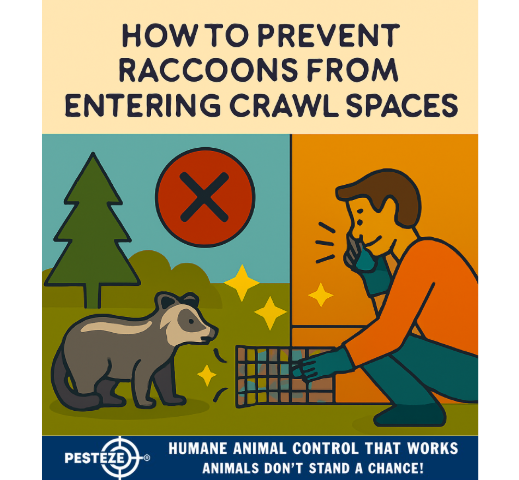HOW TO PREVENT RACCOONS FROM ENTERING CRAWL SPACES

HOW TO PREVENT RACCOONS FROM ENTERING CRAWL SPACES
SUMMARY
Raccoons are clever and persistent animals that often seek shelter in crawl spaces, especially during colder months or breeding seasons. Their presence can lead to property damage, foul odors, and potential health risks. This guide offers effective, humane strategies to prevent raccoons from entering crawl spaces, including sealing techniques, deterrents, and maintenance tips. With proactive measures, you can protect your home and avoid costly infestations.
FEATURES
-
Inspect for Entry Points: Check vents, gaps, and foundation cracks that raccoons could use to gain access.
-
Seal Openings with Durable Materials: Use hardware cloth, metal flashing, or concrete to block potential entryways.
-
Install Vent Covers and Screens: Secure crawl space vents with raccoon-proof covers to prevent intrusion.
-
Use Natural and Motion-Based Deterrents: Apply scent repellents or install motion-activated lights and sprinklers.
-
Keep the Area Clean and Dry: Remove debris, standing water, and food sources that attract wildlife.
-
Schedule Regular Property Checks: Inspect crawl spaces seasonally to catch early signs of activity or damage.
GUIDE DESCRIPTION
Crawl spaces offer warmth, darkness, and protection—making them ideal nesting spots for raccoons. Unfortunately, their presence can lead to torn insulation, chewed wires, contaminated surfaces, and even structural damage. Preventing access is far easier and safer than removing raccoons after they’ve settled in.
Start by inspecting your property for entry points. Raccoons can squeeze through surprisingly small gaps, so check for cracks in the foundation, loose siding, broken vents, and gaps around pipes. Pay special attention to areas near trash bins, pet food, or compost piles.
Seal all openings with durable materials. Hardware cloth (a strong wire mesh), metal flashing, and concrete patches are excellent choices. Avoid using foam or soft sealants alone, as raccoons can chew through them. Ensure that all covers are securely fastened and cannot be pried loose.
Install vent covers and screens designed to withstand wildlife intrusion. These should be made of galvanized steel or similar materials and fit tightly over crawl space vents. Some models come with locking mechanisms for added security.
Deterrents can reinforce your physical barriers. Raccoons dislike strong scents like ammonia, vinegar, and predator urine. Apply these around crawl space entrances. Motion-activated lights or sprinklers can also startle and discourage nighttime visitors.
Keep the crawl space clean and dry. Remove leaves, wood piles, and other debris that could serve as nesting material. Fix leaks and ensure proper drainage to eliminate standing water, which attracts pests and wildlife.
Finally, schedule regular inspections. Check crawl spaces at least once per season, especially in fall and winter when raccoons seek shelter. Look for droppings, paw prints, or disturbed insulation as early warning signs.
By combining physical barriers with deterrents and maintenance, you can effectively prevent raccoons from entering crawl spaces and protect your home from damage.
- Amy Chang


Comments 0